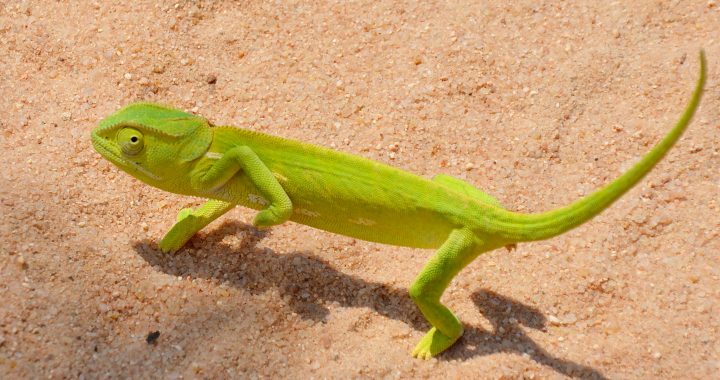Have you ever been lucky enough to witness one of these beauties cross a road unharmed? Or spotted them in your garden? As with everything fragile, these chameleons are silently becoming more rare, as humans continue to fragment their habitat.
The Flap-Necked Chameleon (Chamaeleo dilepis) is native to Sub-Saharan Africa, and is the biggest of the indigenous Chameleon types, reaching 14 – 20cm in length. There are eight recognized subspecies.
Chameleons are from the Lizard family, and a closer look reveals remarkable dinosaur-like features, such as the head of a mini dragon, prehensile five-toed feet and agile tails, eyes that move independently, not to mention a unique way of catching food!
The 360 degree independent eye movements have the handy benefit of watching their backs while simultaneously hunting for prey. Once potential prey has been spotted, both eyes will fixate on it, with binocular-like vision. The brain activity switches between eyes every second or so, to not confuse the animal. The eyelids are fused to allow only a small hole through which to see, but the gaze fixes intensely on preferred prey, for an accurate strike.
Chameleons are insect eaters, using their sticky tongues to catch prey like beetles, bugs and grasshoppers. The lightning fast tongue deployment happens at a speed of 3 hundredths of a second. The tongue extends as long as the body. It is fascinating that such a slow-moving animal can provide such an impressive display of speed when on the hunt.
The swaying, slow gait mimics the swaying of grass in the wind. This helps to camouflage them when at their most vulnerable – on the ground. They are able to change colour faster and in fascinating detail through specialized cells called chromatophores, containing a mixture of pigmented, light-reflecting and melanin cells. Contrary to popular belief, their colour-changing is often a reaction to their moods, or to take full advantage of soaking up the rays of the sun, and not strictly for camouflage as such.
Because they live in trees, finding them on the ground means that they are either looking for a mate, an expanded habitat, or on their way to lay eggs. Unfortunately many flap-necked chameleons get killed by cars when crossing the road. Well-meaning motorists picking them up adds to their mortality, as they die slow deaths when fed flies and kept as pets.
They are a protected species in South Africa - it is not legal for them to be kept without a permit. The road to Sun City outside Rustenburg in South Africa is well-known for illegal selling of wildlife, including chameleons. One should never buy any wildlife offered for sale, as it only stimulates trade, and contributes to extinction. The correct thing to do it to report it to the SPCA who does regular raids on the known trade areas. That is the best chance for these animals to go back into the wild. Sadly, the flap-necked chameleon is in high demand for the international pet trade, being the third most highly traded chameleon species. More than 111,000 individuals were exported between 1977 and 2011, mostly to the USA. Coupled with habitat loss, these figures end up decimating the natural populations.
As with so many of Africa’s vibrant wildlife, superstitions about Chameleons abound. From the idea that they shoot lightning from their eyes, to the belief that they are immortal – these beliefs do very little to protect the species. They are feared and hated among by some people, regarded as a bad omen by others. The only way to fight against this misinformation is to educate people. For instance – the belief that they are immortal, and that chameleon babies are formed by the bones of a dead chameleon, might stem from their habit of digging a hole to lay up to 60 eggs. In the instance of the Flap-necked chameleons, these eggs only hatch in 9 to 12 months, when the hatchlings will dig themselves out of the hole. If the mother didn’t survive, it would surely seem as if the babies came out of her ‘bones’.
When threatened these chameleons will inflate themselves, open their mouths and hiss. They are ready biters too, but although painful, the bites are not venomous. It is no wonder that the word chameleon is the Latinized form of the Ancient Greek khamaileon. The word derives from khamai (on the ground) and leon (lion) and translates loosely as ‘ground lion’. This refers to the reptile’s intimidating defensive display.
Chameleon survival is threatened by Habitat Loss and Fragmentation, the Illegal Wildlife Trade, Domestic Cats and Natural Predators in the Wild, such as Monkeys and Snakes, Pesticides used in gardens, and Human fear resulting in needless killing.




